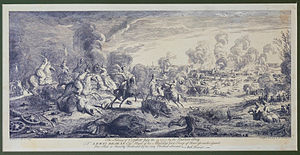| Siege of Ochakov | |||||||
|---|---|---|---|---|---|---|---|
| Part of the Russo-Turkish War (1735–1739) | |||||||
 | |||||||
| |||||||
| Belligerents | |||||||
|
| |||||||
| Commanders and leaders | |||||||
|
Hatibzade Yahya Pasha (POW) Mustafa Pasha (POW) |
Burkhard Christoph von Münnich Alexander Rumyantsev Ludwig Gruno | ||||||
| Strength | |||||||
| 20,000 | 60,000 | ||||||
| Casualties and losses | |||||||
| 17,000 | 4,000 | ||||||
| Russo-Austro-Turkish War (1735–1739) | |
|---|---|
The siege of Ochakov (1737) took place during the Austro-Russian–Turkish War (1735–39) in which the Russian army, led by Burkhard Christoph von Münnich, captured the Ottoman fortress of Ochakov. It took place in 1737.
Siege

The first Russian attack was repelled with heavy losses, but as a result of heavy mortar fire, a fire broke out, and on the second day a powder magazine within the city blew up, killing around 6,000 defenders. The fortress quickly surrendered, but the remaining defenders were massacred by the attackers despite attempting to surrender. In the ensuing slaughter, all but 3,000 of the garrison were killed. The stench of decaying corpses was such that the Russians had to withdraw 15 miles from the fortress.
Aftermath
The Russians razed and abandoned Özi in late 1738 after a disease ravaged the Russian garrison of the fortress, killing 60,000 people. It would not be attacked again until July 1771 in a failed siege. The Russians only managed to regain Özi in December 1788.
Notes
- As a result of Russian mortar fire on the houses within the fortress, fire broke out, and on the second day of the siege, the powder magazine within the city blew up, killing an estimated 6,000 defenders. Thereafter the fortress capitulated, and in the ensuing slaughter, in spite of the white flag, all but 3,000 of the garrison were killed.
References
- Stone 2006, p. 66.
- ^ Aksan 2013, p. 107.
- ^ Баиов А. К. Русская армия в царствование императрицы Анны Иоанновны. Война России с Турцией в 1736-1739 гг. P. 391.
- Henry C. Lodge. The History of Nations. V. XIV. P. F. Collier. 1913. P. 309
- Керсновский А. А. История Русской армии. 2014. P. 74
- Grinevetsky S., Zonn I., Zhiltsov S., Kosarev A., Kostianoy A. The Black Sea Encyclopedia. Springer. 2014. P. 579
- Aksan 2013, pp. 112, 114.
- Creasy, Edward S. (1856). The Ottoman Turks: From the Beginning of their Empire to the Present Time. Vol. 2. London: Richard Bentley. p. 235.
- Duffy C. Russia's Military Way to the West: Origins and Nature of Russian Military Power 1700–1800. Routledge & Kegan Paul Books Ltd. 1985. p. 187
Sources
- Aksan, Virginia H. (2013). Ottoman wars 1700-1870. Routledge.
- Europe and the world, 1650–1830, Jeremy Black
- Stone, David R. (2006). A Military History of Russia: From Ivan the Terrible to the War in Chechnya. Greenwood Publishing Group.
Categories:
- Conflicts in 1737
- Sieges involving the Ottoman Empire
- Sieges involving the Russian Empire
- Military history of Ukraine
- 1737 in the Ottoman Empire
- 1737 in the Russian Empire
- 1730s in Ukraine
- Russo-Turkish War (1735–1739)
- Massacres committed by the Russian Empire
- Massacres in Ukraine
- Ottoman period in Ukraine
- 18th-century prisoner of war massacres
- Ochakiv urban hromada
- History of Mykolaiv Oblast
- 18th century in the Zaporozhian Host
- Building bombings in Ukraine
- Ammunition depot bombings
- Industrial fires and explosions in Ukraine
- Attacks on military installations in Ukraine